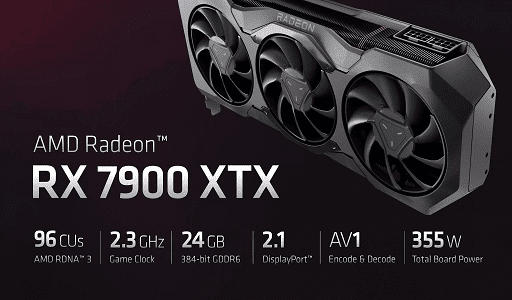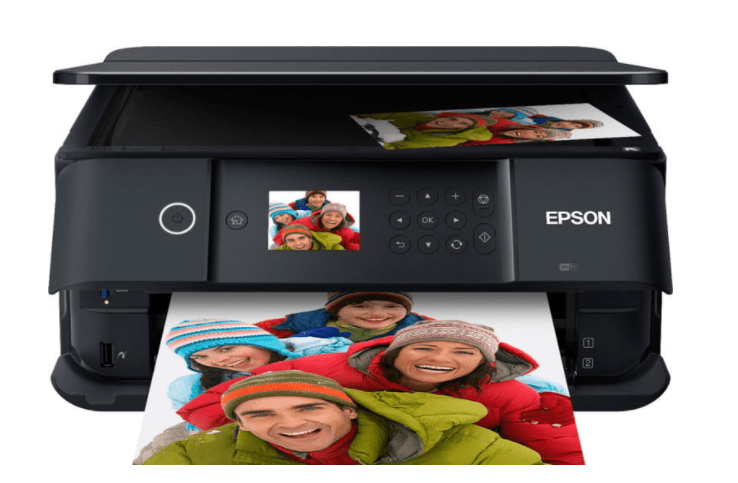Radeon RX 7900 XTX vs. RX 7900 XT: The long-awaited RX 7000 series, or more specifically, AMD’s two top-end GPU flagships, have finally been unveiled. The 7900 XT and 7900 XTX are set to compete with the RTX 4080 and RTX 4090.
Given how different the 4080 and 4090 are, you might wonder if the same thing is happening with the 7900 XT and 7900 XTX. Here’s what we know so far.

RX 7900 XT vs. RX 7900 XTX
Here’s a quick look at how these two models differ on the spec sheet.
| RX 7900 XT | RX 7900 XTX | |
| Architecture | RDNA 3 | RDNA 3 |
| GPU | Navi 31 | Navi 31 |
| Process node | TSMC 5nm (GCD), TSMC 6nm (MCD) | TSMC 5nm (GCD), TSMC 6nm (MCD) |
| Compute Units | 84 | 96 |
| Cores | 5,376 | 6,144 |
| Game clock | 2GHz | 2.3GHz |
| Memory | 20GB GDDR6 | 24GB GDDR6 |
| Memory bus width | 320-bit | 384-bit |
| Infinity Cache | 80MB (unconfirmed) | 96MB |
| TDP | 335W | 355W |
The 7900 XTX essentially has the full Navi 31 GPU with all the bells and whistles, whereas the 7900 XT is slightly reduced. The XT model has 84 of the 96 Compute Units (or CU) that Navi 31 has, a clock speed of 2GHz rather than 2.3GHz on the XTX, 20GB rather than 24GB GDDR6, and a little less Infinity Cache.
Of course, the TDP and clock speed for the 7900 XT are both lower. Overall, the only real difference between the two GPUs will be performance.
You may also like AMD Ryzen 9 7950X vs. Intel Core i9-13900K
RDNA 3 Architecture
Both the 7900 XT and 7900 XTX are powered by the new RDNA 3 architecture, vastly different from RDNA 2, which is found in RX 6000-series GPUs. The two GPUs share the same architecture, but it’s worth looking into if you’re interested in AMD’s latest and greatest.
Most importantly, chiplets, the technology that propelled Ryzen to first place in 2019 have now made their way to GPUs. That’s big news, but the RX 7000’s chiplet design is very different from what we’ve seen with Ryzen and other AMD CPUs. Instead of multiple dies for cores and an extra die for I/O and other functions, RX 7000 GPUs have a single die with all of the cores and several dies with one GDDR6 memory controller and 16MB of Infinity Cache. The chip containing all of the GPU cores is now known as the Graphics Compute Die (GCD), and the chips containing memory controllers and cache are known as Memory Cache Dies (MCD).
This means that an RX 7000 GPU (specifically, the 7900 XTX) can have up to 96MB of Infinity Cache and a 384-bit bus width, allowing the 7900 XTX to reach a peak bandwidth of 5.3 TB/s. Meanwhile, the 7900 XT appears to have one less MCD, resulting in only 80MB of cache, a 320-bit bus, and 4GB less VRAM. Lower-end RX 7000 GPUs will almost certainly use a different GCD and even fewer MCDs, but we won’t know all the details until those are announced next year.
RDNA 3 also includes a new node. RX 6000 GPUs were manufactured on TSMC’s 7nm node; now, RX 7000 GCDs are manufactured on 5nm, which has up to 1.8 times the transistor density of 7nm and offers a 15% clock speed boost for the same power consumption or 30% less power at the same clock speed. When combined with architectural improvements, 5nm is said to make RDNA 3 54% more efficient than RDNA 2.
Meanwhile, the RX 7000’s MCDs are manufactured on TSMC’s 6nm node, which is similar to 7nm but with an emphasis on efficiency, low power, and low cost. Cache and I/O devices, such as memory controllers, are becoming increasingly difficult to shrink with each new generation, which is why AMD is sticking with 6nm for these MCDs; 5nm is simply too expensive while providing little improvement.
You may also like AMD Ryzen 6000 CPU: The Performance Punch Processor
Performance
Still, performance is unquestionably the most important factor for all of us, and AMD has provided some figures for us, but only for the 7900 XTX and only when compared to the 6950 XT. The 7900 XTX outperformed the 6950 XT in six AAA games tested at 4K (three of which also had ray tracing enabled). We could guess that if AMD had tested a 7900 XT, it would be about 1.3 to 1.5 times faster than the 6950 XT, but this is just speculation.
In esports titles, AMD claims the 7900 XTX easily hits 1440p frame rate caps, such as Apex Legends’ 300 frames-per-second (fps) cap and Valorant’s 833 fps cap. On the other end of the spectrum, AMD claims the 7900 XTX can game at 8K resolution, with frame rates well above 60 frames per second. This sounds very similar to Nvidia’s 8K gaming claims, and it appears to be a little too good to be true (AMD admits it requires FSR to achieve these frame rates), but at least the 7900 XTX has DisplayPort 2.1, so it can actually show more than 60 fps at 8K, unlike the RTX 4090.
However, the RX 7000 is more than that. AMD is also introducing FSR 3, which the company claims will deliver up to twice as many frames as FSR 2. It appears that FSR 3 will include a feature called “Fluid Motion Frames,” which could be the secret behind such a large increase in frame rate, but AMD didn’t elaborate much on FSR 3 or “Fluid Motion Frames”; in fact, this detail comes from AMD’s presentation’s endnotes. FSR 3 is set to premiere in 2023.
The RTX 40
After seeing the huge difference between the RTX 4090 and the RTX 4080 (especially the canceled 12GB model), it’s a relief to see the RX 7000 isn’t in the same boat. In terms of GPU launches, the 7900 XT and 7900 XTX are fairly standard, with the XTX model representing the best of what AMD has to offer and the XT being a bit more pared down for a lower price.
So, which GPU should you buy based on this preliminary data? At the moment, the 7900 XTX appears to be the better buy. For an extra $100, you get about 15% more cores, a significantly higher clock speed, and a little more VRAM while consuming roughly the same amount of power. However, we must test them before making final recommendations on how these specifications will play out.
You may also like Intel Core i7-12700K vs. AMD Ryzen 7 7700X
Pricing and release date
The 7900 XT and 7900 XTX were first announced on November 3 and will be available on December 13 for $899 and $999, respectively. The pricing structure is similar to the RX 6000, which had the $999 RX 6900 XT, but we now have an $899 GPU as well.
This could help bridge the gap between the higher-end RX 7000 GPUs and the top-end models; by contrast, the RX 6800 XT launched for $649, which is significantly less than the 6900 XT’s price with no GPU between the two models.
Would you like to read more about Radeon RX 7900 XTX vs. RX 7900 XT-related articles? If so, we invite you to take a look at our other tech topics before you leave!










